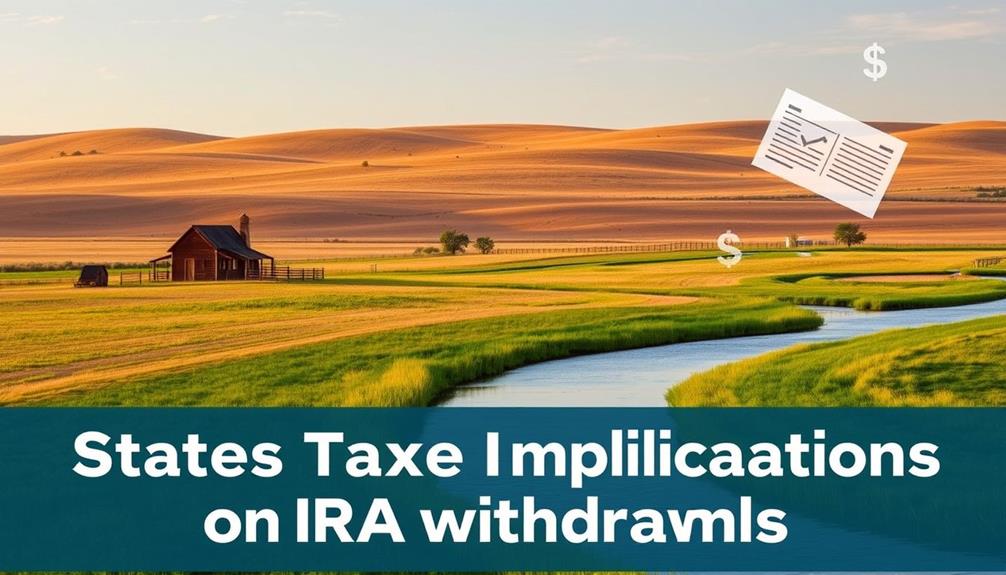By combining a 401(k) with an IRA, you can boost your retirement savings. It’s wise to designate around 50% of your portfolio to a tax-deferred 401(k) in order to maximize employer matches. Consider putting 25% into a Roth IRA for tax-free withdrawals and another 25% into a brokerage account for flexibility and tax management. Remember to also take advantage of Health Savings Accounts (HSAs) for their triple tax benefits. Diversifying your investments and planning for taxes and inflation can significantly improve your financial future. There are effective strategies to enhance this combination, and exploring them can offer even more benefits.
Key Takeaways
- Diversify retirement savings by allocating 50% to tax-deferred accounts, 25% to Roth accounts, and 25% to brokerage accounts for optimal tax management.
- Utilize Health Savings Accounts (HSAs) for triple tax advantages on medical expenses, enhancing your overall retirement savings strategy.
- Regularly review and adjust your asset allocation based on income, expenses, and retirement goals to stay on track for financial security.
- Consider a Gold IRA to hedge against inflation and diversify your investment portfolio beyond traditional retirement accounts.
- Understand the tax implications of inherited IRAs to effectively plan for your beneficiaries and minimize their tax burdens.
Risks of Sole Reliance on 401(k)s and IRAs

Relying solely on 401(k)s and IRAs for retirement savings can expose you to significant financial pitfalls. When you withdraw funds from these tax-deferred accounts, you're often taxed as ordinary income, which can be higher than capital gains rates. This situation becomes even trickier when Required Minimum Distributions (RMDs) kick in at age 73, forcing you to withdraw money regardless of your financial needs and pay taxes on it.
Additionally, incorporating alternatives like Gold IRAs can provide a hedge against inflation and market volatility, enhancing your retirement portfolio's resilience through Gold IRA benefits.
Future tax rate uncertainties add another layer of risk. Projections suggest tax rates may rise, increasing your tax liabilities during retirement. Additionally, if you inherit an IRA, you face complications that require you to liquidate the account within ten years, potentially pushing you into a higher tax bracket.
Relying exclusively on these tax-deferred accounts may hinder your ability to achieve tax diversification. Without a mix of taxable and tax-advantaged investments, managing your tax liabilities effectively becomes a challenge.
To safeguard your financial future, consider diversifying your retirement savings strategy beyond just 401(k)s and IRAs to better navigate the complexities of taxes in retirement.
Benefits of Diverse Investment Options

To secure a robust financial future, embracing a diverse range of investment options is essential. By diversifying your investments across various retirement accounts, including options like a Gold IRA to safeguard against market volatility, you not only enhance your potential returns but also enjoy significant tax benefits.
A well-rounded strategy might include:
- 50% in tax-deferred accounts (like a 401(k) or traditional IRA)
- 25% in Roth accounts for tax-free withdrawals after age 59½
- 25% in brokerage accounts for flexibility and liquidity
- Utilizing a Health Savings Account (HSA) for triple tax advantages
- Considering alternative assets such as real estate or commodities
Each investment type serves distinct financial goals. For instance, Roth accounts offer the flexibility of no required minimum distributions (RMDs), while HSAs provide tax-deductible contributions and tax-free growth.
Additionally, inherited brokerage accounts benefit from a step-up in basis, allowing you to sidestep capital gains taxes, which isn't the case with inherited IRAs.
Effective Money Allocation Strategies

Effective Money Allocation Strategies
When it comes to effective money allocation strategies, balancing your investments across various retirement accounts is essential for long-term success. Aim to diversify your retirement savings by allocating 50% of your portfolio to tax-deferred accounts like a traditional 401(k) plan. This strategy allows you to maximize contributions, especially to take full advantage of your employer match, which can greatly enhance your overall retirement savings.
Additionally, consider incorporating a Gold IRA to hedge against inflation and economic uncertainty, as it can be a valuable component of your retirement portfolio for diversification of investments.
For 2024, remember the contribution limit for 401(k) plans is $23,000, with an additional $7,500 catch-up contribution if you're 50 or older. After you've maximized your 401(k) contributions, consider placing 25% each in Roth accounts and brokerage accounts. This allocation helps mitigate future tax liabilities and offers flexibility for tax-free withdrawals in retirement.
Don't overlook Health Savings Accounts (HSAs), either. They provide unique tax advantages with tax-free contributions, growth, and withdrawals for qualified medical expenses.
Regularly review and adjust your asset allocation strategy based on your changing income, expenses, and retirement goals to guarantee your savings remain aligned with your financial objectives. By effectively managing your funds now, you're setting the stage for a secure and comfortable retirement.
Impact of Taxes and Inflation

Understanding the impact of taxes and inflation is crucial for optimizing your retirement savings strategy. As you plan for a secure retirement, keep in mind how these two factors can notably affect your financial well-being.
- Higher future tax rates could increase your tax liabilities on withdrawals from traditional 401(k)s and IRAs, taxed as ordinary income.
- Inflation historically averages around 3% annually, eroding your purchasing power.
- Required Minimum Distributions (RMDs) start at age 73, forcing you to withdraw funds and potentially push you into higher tax brackets.
- You may need 70-90% of your pre-retirement income to maintain your lifestyle, emphasizing the importance of planning for both tax and inflation impacts.
- Thorough retirement planning should account for expected tax rates and inflation to guarantee you don't underestimate your necessary savings.
Planning for Beneficiaries and Estate

Effective estate planning is vital for guaranteeing that your hard-earned retirement savings are passed on to your chosen beneficiaries with minimal tax consequences.
When considering your retirement accounts, it's important to understand the tax implications of inherited IRAs. Non-spouse beneficiaries must liquidate these accounts within ten years, which can lead to a significant tax burden.
Regularly reviewing and updating your beneficiary designations helps guarantee your assets are distributed according to your wishes, reducing potential conflicts among heirs. Incorporating a trust into your estate plan can also manage the distribution of retirement assets, giving you control over how and when beneficiaries receive their funds.
Don't forget to communicate your retirement planning strategies with your beneficiaries. They should understand the distribution rules and the tax implications associated with inherited accounts.
Consider using Roth IRAs for your beneficiaries, as they allow for tax-free withdrawals, simplifying the tax burden compared to traditional IRAs. By proactively planning for your beneficiaries, you can maximize your financial legacy and support your loved ones effectively.
Frequently Asked Questions
How Can I Maximize My 401K Savings?
To maximize your 401(k) savings, contribute enough to get your employer's full match, automate your contributions, diversify your investments, and regularly review your strategies and fees for peak growth and returns.
What Is the a Month Rule for Retirement?
Saving $1,000 a month can help you accumulate over $1 million in 30 years at a 7% return. This rule emphasizes consistent contributions, automating savings, and diversifying your investments for a secure retirement.
What Is the Best 401K Allocation Strategy?
To optimize your 401(k) allocation, consider the "100 minus age" rule, diversify across fund types, rebalance regularly, minimize fees, and take full advantage of employer matching contributions. These strategies can enhance your retirement savings substantially.
How to Aggressively Save for Retirement?
You're not just saving; you're building a fortress against financial uncertainty! To aggressively save for retirement, crank up your contributions, snag employer matches, and explore HSAs for a powerful, tax-savvy savings strategy.
Conclusion
To maximize your retirement savings, don't just rely on your 401(k) or IRA—diversify your investments, allocate your money wisely, and consider the impact of taxes and inflation. Plan for your beneficiaries and guarantee your estate is secure. By blending these strategies, you're setting yourself up for a more comfortable retirement. Remember, it's not just about saving; it's about saving smart. Start today, stay informed, and watch your financial future grow.










